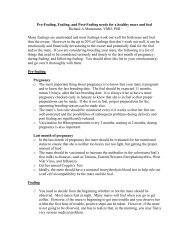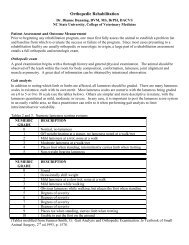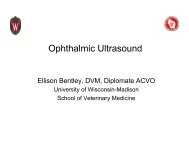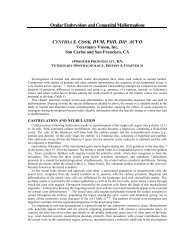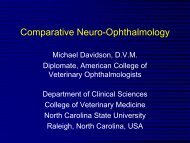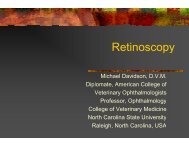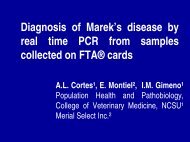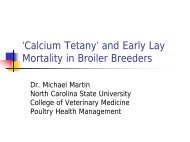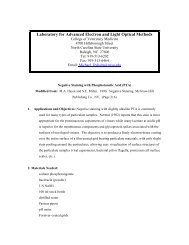Visual Pathways - North Carolina State University College of ...
Visual Pathways - North Carolina State University College of ...
Visual Pathways - North Carolina State University College of ...
Create successful ePaper yourself
Turn your PDF publications into a flip-book with our unique Google optimized e-Paper software.
<strong>Visual</strong> <strong>Pathways</strong><br />
Michael Davidson<br />
Pr<strong>of</strong>essor, Ophthalmology<br />
Diplomate, American <strong>College</strong> <strong>of</strong><br />
Veterinary Ophthalmologists<br />
Department <strong>of</strong> Clinical Sciences<br />
<strong>College</strong> <strong>of</strong> Veterinary Medicine<br />
<strong>North</strong> <strong>Carolina</strong> <strong>State</strong> <strong>University</strong><br />
Raleigh, <strong>North</strong> <strong>Carolina</strong>, USA
<strong>Visual</strong> Cortex
<strong>Visual</strong> Fiber (Retinotopic)<br />
Segregation<br />
• each cerebral hemisphere receives information<br />
from contralateral visual field<br />
• nasal retinal fibers decussate, temporal retinal<br />
fibers do not…right nasal hemiretinal fibers cross<br />
over project to left cerebrum, right temporal fibers<br />
remain uncrossed and project to right cerebrum<br />
• target in right half <strong>of</strong> visual field (right visual<br />
hemifield) ⇒ right nasal retina and left temporal<br />
retina ⇒ left optic tract ⇒ left dLGN ⇒ left<br />
cerebral hemisphere
<strong>Visual</strong> Fiber (Retinotopic)<br />
Segregation<br />
• each cerebral hemisphere receives information<br />
from contralateral visual field<br />
• nasal retinal fibers decussate, temporal retinal<br />
fibers do not…right nasal hemiretinal fibers cross<br />
over project to left cerebrum, right temporal fibers<br />
remain uncrossed and project to right cerebrum<br />
• target in right half <strong>of</strong> visual field (right visual<br />
hemifield) ⇒ right nasal retina and left temporal<br />
retina ⇒ left optic tract ⇒ left dLGN ⇒ left<br />
cerebral hemisphere
Nasal<br />
Retina =<br />
Temporal<br />
hemifield<br />
Fibers<br />
Decussate<br />
Temporal<br />
Retina =<br />
Nasal<br />
hemifield<br />
Fibers<br />
Remain<br />
Ipsilateral
OD <strong>Visual</strong> Field<br />
OD<br />
OS
<strong>Visual</strong> Fiber (Retinotopic)<br />
Segregation<br />
• each cerebral hemisphere receives information<br />
from contralateral visual field<br />
• nasal retinal fibers decussate, temporal retinal<br />
fibers do not…right nasal hemiretinal fibers cross<br />
over project to left cerebrum, right temporal fibers<br />
remain uncrossed and project to right cerebrum<br />
• target in right half <strong>of</strong> visual field (right visual<br />
hemifield) ⇒ right nasal retina and left temporal<br />
retina ⇒ left optic tract ⇒ left dLGN ⇒ left<br />
cerebral hemisphere
<strong>Visual</strong> Fiber Segregation<br />
Object in right visual<br />
hemifield projects to:<br />
- right nasal hemiretina<br />
- left temporal<br />
hemiretina<br />
- left cerebrum<br />
Object in left visual<br />
hemifield projects to:<br />
- left nasal hemiretina<br />
- right temporal<br />
hemiretina<br />
- right cerebrum
Assessing Vision and <strong>Visual</strong> <strong>Pathways</strong><br />
• evaluate PLR<br />
• menace response<br />
• (optic) dazzle reflex<br />
• patching or occluding may be necessary<br />
• photopic and scotopic obstacle course
Evaluating Vision and <strong>Visual</strong> <strong>Pathways</strong><br />
• electroretinogram<br />
• visually-evoked response<br />
• optokinetic reflex<br />
• visual cliff<br />
- indicator <strong>of</strong> visual system and other areas <strong>of</strong> cortex<br />
- large animals=birth<br />
- dogs/cats = 4 weeks<br />
• visual placing reaction<br />
- hold in air, advance to table edge, both forelegs will extend<br />
- lesions in rostral portion <strong>of</strong> striate cortex or foreleg region <strong>of</strong><br />
motor cortex will abolish visual placing reaction in<br />
contralateral visual field
Pupillary Light Reflex and <strong>Visual</strong> <strong>Pathways</strong><br />
PLR and Vision<br />
Abnormal<br />
PLR normal<br />
Vision Abnormal
Menace Response<br />
• cortically mediated eyelid closure +/- head<br />
withdrawal and eyeball retraction<br />
- complex, not true reflex but response<br />
• requires intact retina, optic nerve/tract/radiation,<br />
visual cortex, inter-cerebral cortices pathways, and<br />
CN VII<br />
• undefined connection with cerebellum<br />
- cerebellar lesion results in ipsilateral menace response<br />
loss with normal vision<br />
- may result from pathway passing through cerebellum OR<br />
from loss <strong>of</strong> cerebellar facilitation/modulation <strong>of</strong> motor<br />
cortex<br />
• cortical lesions causes loss <strong>of</strong> contralateral visual<br />
field
Motor Cortex<br />
<strong>Visual</strong> Cortex<br />
LGB<br />
Cerebellum<br />
Obicularis<br />
oculi mm<br />
<strong>Visual</strong> input<br />
CN VII<br />
CN VII Nuclei
(Optic) Dazzle Reflex Test<br />
• partial eyelid blink in response to bright light<br />
- subcortical<br />
- eyelids may open then close<br />
- contralateral closure < or sometimes absent<br />
• optic nerve to midbrain, rostral colliculi<br />
• afferent=subcortical input to superior or rostral<br />
colliculi and/or supraoptic nuclei <strong>of</strong> hypothalamus<br />
• efferent= CN VII
DAZZLE REFLEX<br />
Obicularis oculi mm.<br />
CN II<br />
CN VII<br />
LGB<br />
Pretectal Nuclei<br />
Rostral Colliculi<br />
<br />
CN VII<br />
nuclei
Other Rostral Colliculus-Mediated<br />
<strong>Visual</strong> Reflexes<br />
• Coordination <strong>of</strong> eye movements in<br />
response to visual stimulus (gaze center to<br />
CN III, IV, VI)<br />
• Turning <strong>of</strong> head in response to visual<br />
stimulation (motor fibers in spinotectal<br />
tract)<br />
• Reticular activation system (activates<br />
cortex)
Hemianopia (vision loss/deficit in ½ <strong>of</strong><br />
visual field in one or both eyes)<br />
• homonymous hemianopia:<br />
- loss <strong>of</strong> one hemivisual field<br />
(e.g. loss <strong>of</strong> right visual field<br />
from loss <strong>of</strong> nasal retinal<br />
fibers in right eye and<br />
temporal fibers in left eye)<br />
- any unilateral lesion caudal<br />
to chiasm<br />
• heteronymous hemianopia:<br />
- loss <strong>of</strong> two hemivisual fields<br />
(e.g. loss <strong>of</strong> both temporal<br />
visual fields from loss <strong>of</strong><br />
both nasal retinal fibers):<br />
- chiasmal lesions if affect<br />
only crossed fibers<br />
• quadrantic hemianopia:<br />
- partial unilateral lesion<br />
caudal to chiasm
Characteristics <strong>of</strong> <strong>Visual</strong><br />
Pathway Lesions<br />
• Retinal neuronal chain<br />
• Pre-chiasmal optic nerve<br />
• Optic chiasm<br />
• Optic tract<br />
• Lateral geniculate body<br />
• Optic radiation<br />
• Occipital (visual) cortex<br />
• Parietal lobe<br />
• Motor cortex
Retinal Chain, Intraocular Retinal<br />
Ganglion Lesions<br />
• lack <strong>of</strong> direct and<br />
consensual (to fellow eye)<br />
PLRs<br />
• positive swinging<br />
flashlight test/cover<br />
uncover (Marcus-Gunn<br />
pupil)<br />
• visual deficits/blindness<br />
• menace/optic dazzle<br />
deficits<br />
• perform funduscopic<br />
exam<br />
• PLRs may persist with<br />
advanced retinal disease<br />
and visual deficits<br />
(ipRGCs, high intensity<br />
blue light stimuli)
Unilateral Prechiasmal Optic<br />
Nerve Lesions<br />
Left<br />
Right<br />
• signs identical to<br />
retinal disorders<br />
• positive swinging<br />
flashlight test
Optic Chiasmal Lesions<br />
Left Right Left Right<br />
• total lesions cause bilateral<br />
PLR and visual deficits<br />
• PLR deficits recognized<br />
before visual deficits<br />
• abnormalities in behavior,<br />
appetite, temperature<br />
regulation, endocrine<br />
function dysfunction and<br />
visceral motor activities
Unilateral Optic Tract Lesions<br />
• similar to unilateral retinal or<br />
prechiasmal optic nerve but<br />
more dilated pupil contralateral<br />
to lesion<br />
• subtle anisicoria<br />
• negative swinging flashlight test<br />
• more miotic pupil persists in the<br />
same eye regardless <strong>of</strong> which<br />
eye is stimulated<br />
• visual field contralateral to<br />
affected tract is diminished or<br />
lost<br />
- contralateral homonymous<br />
hemianopia<br />
- vision loss most obvious in eye<br />
contralateral to lesion<br />
Left<br />
Left<br />
75%<br />
fibers OS<br />
25%<br />
fibers OD
• proximity to<br />
internal capsule<br />
(all afferent and<br />
efferent fibers to<br />
and from cortex)<br />
• contralateral<br />
postural reaction<br />
deficits with normal<br />
gait (proprioceptive<br />
pathways)<br />
• canine distemper<br />
virus tropism<br />
Lesions in Optic Tract
Bilateral Retina, Optic Chiasm<br />
Optic Nerve or Tract Lesions<br />
• lesions in both retinas ><br />
chiasm > both optic<br />
nerves> optic tracts<br />
• bilateral mydriasis, PLR<br />
deficits, visual deficits<br />
commensurate with<br />
lesion
Lesions <strong>of</strong> Optic Radiation<br />
• Contralateral<br />
homonymous<br />
hemianopia<br />
Left<br />
Left
Lesions <strong>of</strong> Optic Radiation<br />
• extensive or complete<br />
lesions <strong>of</strong> caudal limb<br />
<strong>of</strong> internal capsule:<br />
- complete contralateral<br />
homonymous<br />
hemianopia<br />
- contralateral<br />
hemiplegia and<br />
hemianesthesia
Unilateral <strong>Visual</strong> Cortex Lesions<br />
• Complete,<br />
contralateral<br />
homonymous<br />
hemianopia
Striate and Extrastriate <strong>Visual</strong> Cortex<br />
• rostral and medial regions:<br />
- steropsis and processing<br />
- analysis<br />
- form, pattern, texture<br />
• rostral region:<br />
- visual placing<br />
• caudal and lateral regions:<br />
- menace blink response<br />
• caudal and medial regions:<br />
- conjugate eye movements (orientation and<br />
attention <strong>of</strong> eyes to visual target)<br />
- corticotectal pathways directly to brainstem
Striate and Extrastriate <strong>Visual</strong> Cortex<br />
• rostral and medial regions:<br />
- steropsis and processing<br />
- analysis<br />
- form, pattern, texture<br />
• rostral region:<br />
- visual placing<br />
• caudal and lateral regions:<br />
- menace blink response<br />
• caudal and medial regions:<br />
- conjugate eye movements (orientation and<br />
attention <strong>of</strong> eyes to visual target)<br />
- corticotectal pathways directly to brainstem
Motor<br />
Cortex<br />
Rostral <strong>Visual</strong><br />
Cortex:<br />
visual placing<br />
forelimbs
Striate and Extrastriate <strong>Visual</strong> Cortex<br />
• rostral and medial regions:<br />
- steropsis and processing<br />
- analysis<br />
- form, pattern, texture<br />
• rostral region:<br />
- visual placing<br />
• caudal and lateral regions:<br />
- menace blink response<br />
• caudal and medial regions:<br />
- conjugate eye movements (orientation and<br />
attention <strong>of</strong> eyes to visual target)<br />
- corticotectal pathways directly to brainstem
Striate and Extrastriate <strong>Visual</strong> Cortex<br />
• rostral and medial regions:<br />
- steropsis and processing<br />
- analysis<br />
- form, pattern, texture<br />
• rostral region:<br />
- visual placing<br />
- to motor cortex<br />
• caudal and lateral regions:<br />
- menace blink response<br />
- to motor cortex<br />
• caudal and medial regions:<br />
- conjugate eye movements (orientation and<br />
attention <strong>of</strong> eyes to visual target)<br />
- corticotectal pathways directly to brainstem
Extraocular<br />
mm.<br />
Caudomedial<br />
<strong>Visual</strong> Cortex:<br />
Conjugate gaze
Complete, Unilateral <strong>Visual</strong><br />
Cortex Lesions<br />
• Complete, contralateral<br />
homonymous<br />
hemianopia<br />
• Loss <strong>of</strong> menace blink<br />
response in<br />
contralateral visual field<br />
• Loss <strong>of</strong> conjugate eye<br />
movements to target in<br />
contralateral visual field<br />
• Loss <strong>of</strong> contralateral<br />
visual placing
• between occipital<br />
cortex and motor<br />
cortex<br />
• loss <strong>of</strong> menace in<br />
contralateral visual<br />
field<br />
• subcortical reflexes<br />
intact (dazzle/PLR)<br />
• no loss <strong>of</strong> vision<br />
• normal motor cortex<br />
(frontal lobe)<br />
function<br />
Parietal Lobe Lesions
Motor Cortex <strong>Visual</strong> Behaviors<br />
• Abnormal menace blink<br />
(if eyelid region <strong>of</strong><br />
motor cortex involved)<br />
• Abnormal visual<br />
placing reaction with<br />
contralateral loss <strong>of</strong><br />
visual placing (if foreleg<br />
region <strong>of</strong> motor cortex<br />
involved)<br />
• NOT conjugate gaze<br />
(orientation and<br />
attention to target<br />
stimuli)….mediated by<br />
striate and extrastriate<br />
visual cortex and not<br />
the motor cortex
QUESTIONS?



